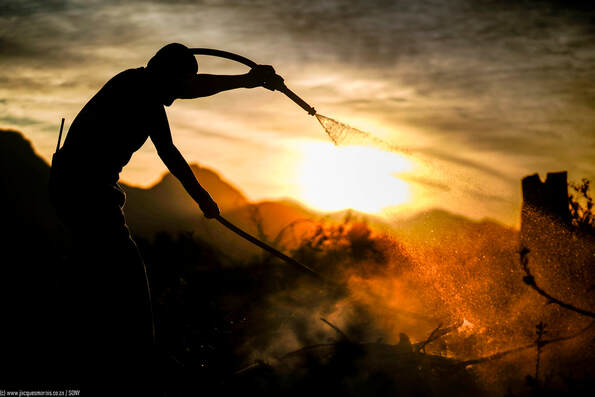Fire management is an important part of guaranteeing the safety of our property. Farmers are faced with the challenge of veld fires every year. The best they can do is to manage this difficult reality.
Several aspects must be considered when planning for the fire season, including the type of vegetation, the legal processes around fire, and not to burn the land excessively. The use of controlled fire can assist in ensuring that our structures are protected against undesired fires. Fire is a natural part of the ecosystem, and we try to safely reflect this in our environment, without risking damage to structures and natural resources.
Actions during veld fires
- Check the speed and direction of the wind, as these determine how far ahead your backfires must be to stop the fire.
- Determine the point at which you will stop the fire and send the persons tasked with this to that spot to do so.
- Move in sections that have already burnt as far as possible, particularly on hot days when whirlwinds occur. Such a whirlwind can cause you to be caught up in the fire.
- Make sure that you always know where you are and where the section is that has already burnt so that you can go there if necessary.
- Do not move forward if the fire is not completely extinguished behind you.
- Always fight the outside edges of the fire first; inside fires can be extinguished later.
- Make sure that you know where the outer flanks of the fire are.
- Always try to work in teams of three hoses, then you are usually sure that the fire behind you is extinguished.
- Always check your vehicle’s heat gauge.
- Always make sure that enough people are involved with the backfire to stop the fire so that a second fire does not start. Only the fire chief can decide where a backfire is to be made.
- Always wear protective clothing and masks.
- Take enough drinking water with and regularly consume water.
- Inform landowners threatened by the fire in time so that they can remove their stock.

Prevent veld fires in this way
- Make and maintain your firebreaks in time every year. Every landowner and tenant is legally obliged to do so.
- Make sure they are free of flammable material – a bush slasher does not create a firebreak.
- Speak to workers regularly and teach them the risks of open fires.
- Make sure those areas where food is prepared on open fires are clear.
- You are advised to make wide firebreaks around your workers’ homes.
- Do not do the following on days when there is a strong wind: – Use cutting wheels near dry grass. – Weld in the open (gates, windmills, straining posts, et cetera). – Grade roads with a grader on stony ground. – Mow with bush slashers. – Grind feed. – Make headlands and burn fields.
- A tractor that has done light work for long periods and is suddenly used for heavy work, can emit sparks from its exhaust, which could cause a fire.
- If you have to do any burning, do it early in the morning.
- Clear the shoulders of secondary roads and keep the grass short so that backfires can be made easily.
To-do list
- Reduce fuel loads and avoid uncontrolled alien vegetation infestation on your land.
- During the cooler months, controlled or prescribed burning is sometimes used and may decrease the likelihood of serious hotter fires. Controlled burning must be overseen by fire control authorities for regulations and permits. Please contact your local municipality or fire brigade.
- Share your plan with your neigh bours and fire protection officer if you have one.
- Make sure your firebreaks are in place and that they are wide and long enough to stop a fire.
- Discuss fire insurance with your insurance broker.
- Make sure contact numbers of fire and rescue services are easily accessible.
- Stay in touch; keep communication lines open. WhatsApp, text messages or radios can be used.
- Decide beforehand who is responsible for what. When a fire breaks out there is no time to allocate responsibilities; everyone must know exactly what they must do. Meet regularly to update your procedures.
References
Furness, A. and Muckett, M., 2007. Introduction to fire safety management. Routledge.
Teie, William C. Fire manager’s handbook on veld and forest fires: strategy, tactics and safety. South African Institute of Forestry, 2003.









